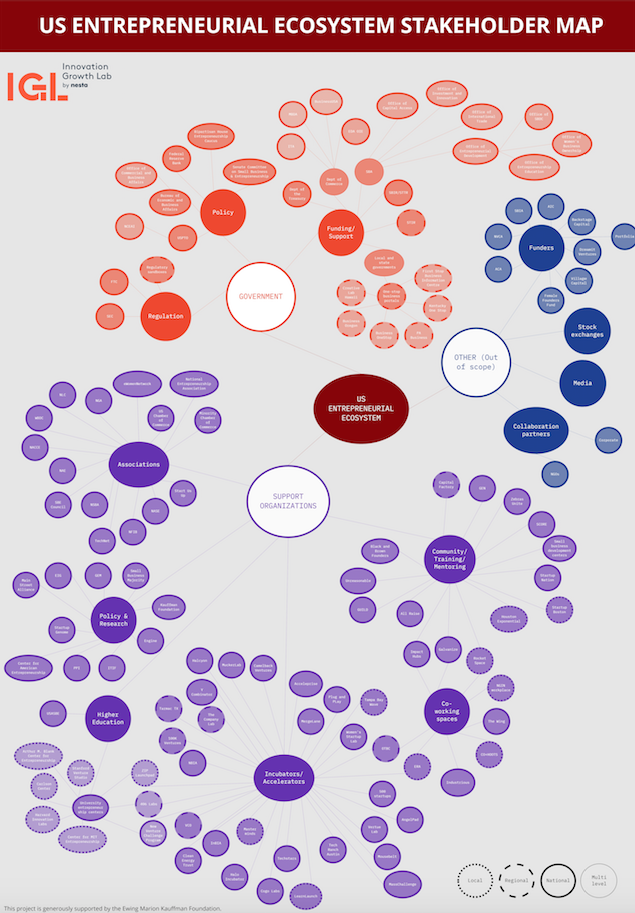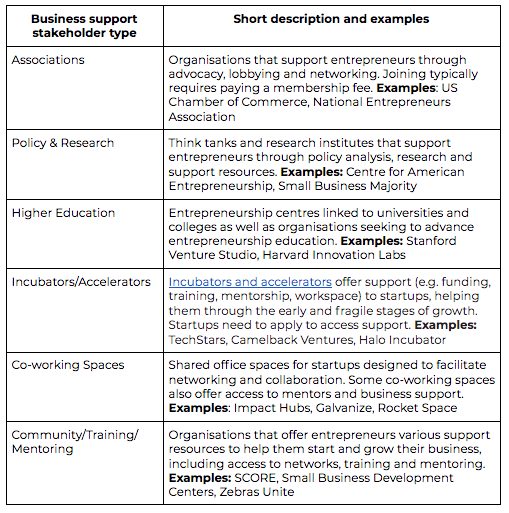
Blog
Bridging the gap between business support research and practice
9 February 2021
Policymakers and business support organisations can use a diverse set of tools to create thriving entrepreneurship ecosystems, ranging from financial support, mentoring to business training. But how can they choose the most effective ones? Our new project, supported by the Kauffman Foundation, aims to signpost effective interventions for business support, by translating the latest scientific evidence into actionable insights for policymakers and business support organisations.
Are you an academic, business support provider or policymaker? Complete our open call if you would like to share evidence, suggest priority areas, or help us identify key business support stakeholders in the US!
The evidence base is growing, but policy makers and business support providers struggle to access it
In recent years, the body of rigorous evidence on the effect of business support has been growing, making it easier to assess which interventions actually drive business survival, productivity and/or growth. This is in part thanks to the research funding efforts of the Kauffman Foundation, Nesta and the Argidius Foundation through the IGL Grants Programme, which has provided direct support to more than 40 randomised controlled trials (RCTs) over the last 5 years.
Yet, policymakers and support organisations often struggle to access the latest evidence, typically due to a lack of time and resources. Understandably, it can be difficult to find relevant academic studies, assess their methodological rigor and interpret the results. At the same time, academic researchers also tend to lack the resources to translate their findings to specific policy contexts. Our new project, supported by the Kauffman Foundation, aims to bridge both worlds and facilitate the translation of research findings into actionable outputs for policymakers and business support providers.
In the next few months, we will organise workshops with key policy and business support stakeholders in the United States to understand their priority areas and evidence needs. We will then create a series of short, digestible, stakeholder-informed outputs that summarise the existing evidence.
Complete our open call if you would like to share evidence, suggest priority areas, or help us identify key business support stakeholders in the US!
What have we done so far? Mapping the US entrepreneurial ecosystem
We started by mapping policy and business support stakeholders in the United States entrepreneurship ecosystem. This was a daunting task given that there are hundreds, if not thousands, of organisations on a federal, state and local level. To create a stakeholder map, we followed a three-step process (continue reading below the figure).

US entrepreneurial ecosystem stakeholder map. Open in Miro to browse the map. Help us identify gaps by completing our open call or by adding comments directly to the map.
1. Identify stakeholder categories
We carried out a literature review to identify key stakeholder types for thriving entrepreneurship ecosystems. The World Economic Forum’s “eight pillars of an entrepreneurial ecosystem”, including funding & finance, support systems/mentors, government & regulatory framework and universities, was a helpful starting point. We then consulted stakeholder maps of entrepreneurship ecosystems across the globe, for example in the UK, Denmark and Palestine. Based on these sources, we defined three government stakeholder categories (Regulation, Policy, Funding/Support) and six support organisation stakeholder categories (see table below).

2. Identify key stakeholders
Next, we consulted online databases of entrepreneurship stakeholders. The Global Entrepreneurship Network’s Member Directory and Atlas were useful resources to identify policy and support organisations. Startup Blink directed us towards coworking spaces and accelerators across the United States. We also spoke to entrepreneurs with direct experience of the United States ecosystem, which helped us cover specific stakeholders, such as those focused on tech startups (e.g., Techstars) or on impact entrepreneurship (e.g., Zebras Unite). Finally, we consulted online resources about federal efforts in supporting entrepreneurship, small business associations and accelerators, to name a few.
3. Organise stakeholders and create a stakeholder map
We ended up with a long list of over 120 organisations in the US entrepreneurial ecosystem. Next, we organised them by category and indicated whether they operate on a local, regional or national level. Finally, we created a visual stakeholder map in Miro. Of course, the map is not a comprehensive representation of all organisations working in this space, but we hope it will serve as a useful reference for those seeking to navigate the US ecosystem.
Where next?
We will directly engage with a number of key stakeholders to understand what their priorities and evidence needs are for business support programmes. We’d also like to hear from you!
Complete our open call if you would like to share evidence, suggest priority areas, or help us identify key business support stakeholders in the US!
If you have any questions about this project, please contact [email protected]
This project is generously supported by the Ewing Marion Kauffman Foundation. Any opinions, findings, and conclusions or recommendations expressed in project materials are those of the author(s) and do not necessarily reflect the views of the Ewing Marion Kauffman Foundation
